![]()
![]()
![]()
Use LEFT and RIGHT arrow keys to navigate between flashcards;
Use UP and DOWN arrow keys to flip the card;
H to show hint;
A reads text to speech;
14 Cards in this Set
- Front
- Back
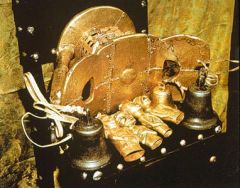
|
T: Golden Stool D: c.1700 P/S: African Art A: Ashanti People P: Osei Tutu OL: South central Ghana M/T: Gold, bells, wood, Divine Funiture F: House the spirit of the Ashante nation C: Descended down from heaven to the King DT: Throne, Images on it |
|
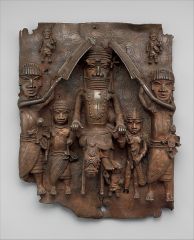
|
T: Wall Plaque from Oba's Palace D: 16th century C.E. P/S: African/ Kush A: Edo People P: High Class Edo People OL: Benin (Nigeria) M/T: Cast Brass, Ivory, Terracotta and Wood Metallurgy F: Serve as a Power and Social Status Symbol C: Only used my royals and wealthy DT: Plaque, EngravingM: Honor Oba King |
|

|
T: Great Mosque of Djenné D:1200 CE, rebuilt A: Uknown P:Unknown OL: Mali M:adobe mud bricks P/S: African art DT:mud bricks, religious worshipping C: political power house, Islamic teachings during the Middle Ages |
|

|
T: Conical Tower and Circular Wall of Great Zimbabwe A: People of Zimbabwe D: 1000-1400 C.E M: Carsed granite blocks, soapstone P/S: Kush P: Unknown OL: Southeastren Zimbabwe F: Trading place, mutlifunction C: Early human settlement DT: Stone wall |
|
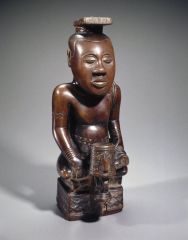
|
T: Ndop (portrait figure) of King Mishe miShyaang maMbul A: Skilled worker of tribe D: 1760 - 1780 CE M: Wood P/S:African F: Commerate every Kuba King P: King Mishe DT: Power Figure Smooth Symbol Showed As Leader C: Meaning is to serve as power structure which they believe had power that they could use from leader of tribe |
|
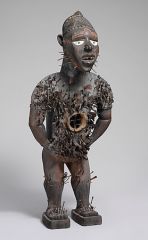
|
T: Power Figure (Nkisi n’kondi) Kongo peoples A: Kongo Peoples D: Late 19th century CE M: Wood and Metal OL: Democratic Republic of the Congo P/S: African F: Highlight functions in human affairs P: N/A DT: Bakongo, and spirit C: A spirit that's represented by a container of sacred substances which are activated by supernatural forces |
|
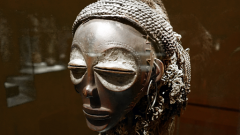
|
T: Female (Pwo) Mask A: Chokwe People D: Late 19th to early 20th century M: Wood, Fiber, Pigment, and Metal OL: Democratic Republic of the Congo P/S: African Art F: Used in rituals where men dress and honor women P: Chokwe people DT: mask, ancestor, ritual C: Depicts the female deity Pwo who represent fertility: shows the idealized woman |
|
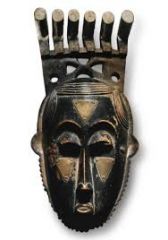
|
T: Portrait Mask (Mblo) A: Baule Peoples D: Early 20th Century CE M: Wood and Pigment OL: Central Côte d’Ivoire in West Africa P/S: African F: The belief in honoring the matriarch and ancestors, importance of females, and refinement and desire to pleasure others. P: NA DT: Symbolism C: Honoring the matriarch of the family, also honoring ancestors The masks denote personal beauty, refinement, and a desire to give pleasure to others. |
|
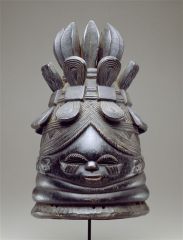
|
T: Bundu mask A: Sande Society, Mende people D: 19th to 20th century C.E. M: wood, cloth, fiber P/S: African OL: West African forests of Sierra Leone and Liberia P: N/A F: worn for initiation, to instruct young girls about proper womanhood DT: little mouth, petite ears, high, glossy forehead, wild elaborate hair style, serious C: Downcast eyes suggest that she should be reserved. The small mouth suggest she should keep her mouth closed and not gossip. Small ears suggest not to listen to that gossip. Rolls of fat under chin suggest that she is full-figured and has enough body fat to be able to bear children. |
|
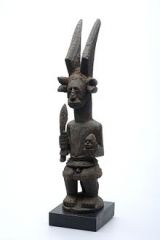
|
T: Ikenga (shrine figure) A: Igbo Peoples D: 19-20th Centuries M: Wood P/S: African/ Igbo OL: Nigeria P: N/A F: signify the achievements or abilities of their owners DT: abstract, naturalistic, symbolism, ritual, and icon C: Right hand holds a sword in their right hand as a symbol of power,Left hand holds variety of items (ex: elephant tusk or head) ,The literal meaning of Ikenga is place of strength but also stands for the power of the right handhorns symbolize the strength of the head |
|
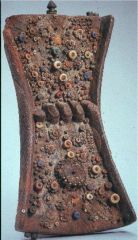
|
T: Lukasa (memory board) A: Luba peoples D: 19th to 20th century C.E. M: Wood, beads, and Metal P/S: African Art OL: Democratic Republic of the Congo, Africa P: N/A F: serve as a memory aid that describes the myths surrounding the origins of the Luba empire DT: carvings of relief, geometric designs, beading C: each board’s design is based on what memories are important to the patron, a single colored bead = specific individual, a large bead surrounded by smaller ones = chief & his dignitaries, the lines of the beads represents a journey or path |
|
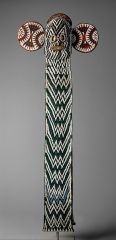
|
T- Aka Elephant Mask A- Bamileke Peoples D- 1100-1980 C.E. M- Cloths, beads, raffia, fibers P/S- Kuosi Society OL- Region of Cameroon P- High ranking officials F- Honors the king, Shows the power of the king. DT- Beads, Social Harmony, Elephant C- Used in masquerades with costumes and performers and musicians that brought the mask to life |
|
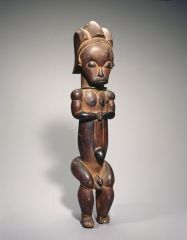
|
T: Reliquary Figure (Byeri) A: Fang peoples D: 19th to 20th century C.e. M/T: Wood P/S: Ancestral relics OL: Southern Cameroon P: Byeri F: The figure held great spiritual power, devoted to the veneration of lineage ancestors and people who made significant contributions to the community. DT: figure, honorable statue, remembrance of the importance C: After death the relics were conserved cylindrical bark containers and were protected by carved wooden heads. Used palm oil for ritual purification. The sculpture can be male or female, and they were decorated with jewelry and gifts. |
|
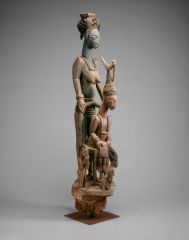
|
T: VERANDA POST OF ENTHRONED KING AND SENIOR WIFE (OPO OGOGA) A: Fang peoples D: 19th to 20th century C.e. M/T: Wood P/S: Ancestral relics OL: Southern Cameroon P: Opo Ogoga F: The figure held great spiritual power, devoted to the veneration of lineage ancestors and people who made significant contributions to the community. DT: figure, honorable statue, remembrance of the importance C: After death the relics were conserved cylindrical bark containers and were protected by carved wooden heads. Used palm oil for ritual purification. The sculpture can be male or female, and they were decorated with jewelry and gifts. |

